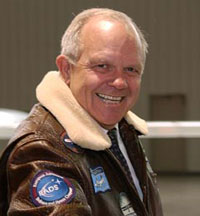Steve Fossett remains missing for second week
US aviator Steve Fossett remain missing for second week amid frustration growing among rescue teams. The search for Fossett covers 17,000 square miles (44,000 square kilometers) over mostly Nevada wilderness and parts of California.

"This search is big, it is frustrating and it is exhausting, physically and mentally," Civil Air Patrol Maj. Cynthia Ryan said.
"What's so frustrating is we haven't found anything," added Lyon County Undersheriff Joe Sanford after another potential sighting Sunday afternoon turned up no sign of the millionaire adventurer.
For the first time on Sunday, the focus shifted to a 50-mile (80-kilometer) radius around the private airstrip Fossett took off from Sept. 3 southeast of Reno.
For a moment, the change in strategy appeared to pay off as leaders of the operation quickly assembled reporters for a briefing at Minden-Tahoe Airport to announce a helicopter and ground crew were en route to a possible sighting.
But a half-hour later, the ground crew arrived at the scene and confirmed the wreckage was "not the target aircraft."
"Once again you had your hopes raised and dashed just as we have," Ryan told reporters.
The debris was from an old U.S. Navy crash, said Kim Toulouse, a spokesman for the Nevada Department of Wildlife. He had no other details.
Later Sunday, search crews discovered yet another old crash site but could tell it was not Fossett's plane without dispatching a ground crew, he said.
"We're finding them left and right. Nevada is a graveyard," Toulouse said. "The technology we have today is allowing us to find this stuff."
It was at least the eighth time since Fossett disappeared that search crews thought they had located him only to learn the wreckage came from crashes that were years or even decades old.
Fossett's wife, Peggy, remained Sunday at hotel magnate Barron Hilton's ranch. Fossett took off from it in a single-engine plane on what was to be a three-hour trip. Hilton's crews have assisted in the search.
Sanford said Sunday he had spoken to members of Fossett's family.
"The mood is very somber but very focussed," Sanford said. "I can't imagine being on the receiving end of hope that continues to turn out to be unfounded or be something we were not aware of."
Nevertheless, he said the family and search crews remain "very dedicated and very focussed."
"These are the best search and rescue people we have," Sanford said. "We are going to find Mr. Fossett and we are going to bring him home."
Fossett, a former commodities trader who was the first to circle the globe in a balloon, is considered an expert pilot and survivalist.
The focus shifted to the 50-mile (80-kilometer) circle around the airstrip because most crashes occur within that radius, Ryan said.
"We've got close to 100 percent covered, at least in some cursory fashion," Ryan said. "We have to eliminate a lot of territory."
The discovery of at least eight previously unknown wrecks suggests how difficult it might be to find Fossett's single-engine Bellanca Citabria Super Decathlon.
The Florida-based Air Force Rescue Coordination Center, which is helping coordinate the search, maintains a registry of known plane wreck sites.
The registry has 129 entries for Nevada. But over the past 50 years, aviation officials estimate, more than 150 small planes have disappeared in the state, which has more than 300 mountain ranges carved with steep ravines and covered with sagebrush and pinon pine trees. Peaks rise to 11,000 feet (3,350 meters).
"The mountains are quite rugged, and things don't always get found," Ryan said.
Subscribe to Pravda.Ru Telegram channel, Facebook, RSS!


